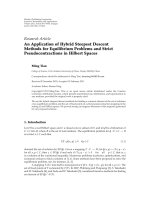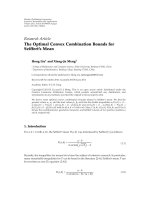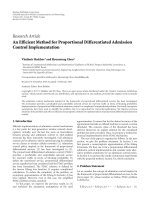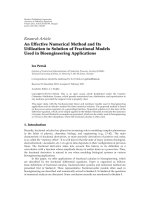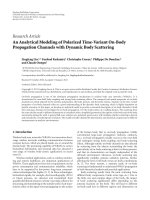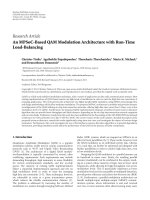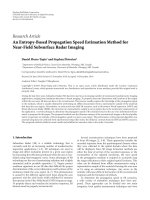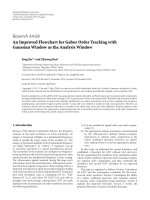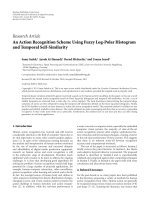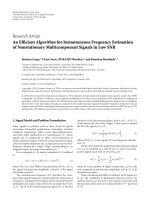Báo cáo hóa học: " Research Article An Optimal Double Inequality between Power-Type Heron and Seiffert Means" docx
Bạn đang xem bản rút gọn của tài liệu. Xem và tải ngay bản đầy đủ của tài liệu tại đây (489.81 KB, 11 trang )
Hindawi Publishing Corporation
Journal of Inequalities and Applications
Volume 2010, Article ID 146945, 11 pages
doi:10.1155/2010/146945
Research Article
An Optimal Double Inequality between
Power-Type Heron and Seiffert Means
Yu-Ming Chu,
1
Miao-Kun Wang,
2
and Ye-Fang Qiu
2
1
Department of Mathematics, Huzhou Teachers College, Huzhou 313000, China
2
Department of Mathematics, Zhejiang Sci-Tech University, Hangzhou 310018, China
Correspondence should be addressed to Yu-Ming Chu,
Received 29 August 2010; Accepted 16 November 2010
Academic Editor: Alexander I. Domoshnitsky
Copyright q 2010 Yu-Ming Chu et al. This is an open access article distributed under the Creative
Commons Attribution License, which permits unrestricted use, distribution, and reproduction in
any medium, provided the original work is properly cited.
For k ∈ 0, ∞, the power-type Heron mean H
k
a, b and the Seiffert mean Ta, b of two positive
real numbers a and b are defined by H
k
a, ba
k
ab
k/2
b
k
/3
1/k
, k
/
0; H
k
a, b
√
ab,
k 0andTa, ba − b/2arctana − b/a b, a
/
b; Ta, ba, a b, respectively. In this
paper, we find the greatest value p and the least value q such that the double inequality H
p
a, b <
Ta, b <H
q
a, b holds for all a, b > 0witha
/
b.
1. Introduction
For k ∈ 0, ∞, the power-type Heron mean H
k
a, b and the Seiffert mean Ta, b of two
positive real numbers a and b are defined by
H
k
a, b
⎧
⎪
⎪
⎨
⎪
⎪
⎩
a
k
ab
k/2
b
k
3
1/k
,k
/
0,
√
ab, k 0,
1.1
T
a, b
⎧
⎪
⎨
⎪
⎩
a − b
2arctan
a − b
/
a b
,a
/
b,
a, a b,
1.2
respectively.
2 Journal of Inequalities and Applications
Recently, the means of two variables have been the subject of intensive research 1–
15. In particular, many remarkable inequalities for H
k
a, b and Ta, b can be found in the
literature 16–20.
It is well known that H
k
a, b is continuous and strictly increasing with respect to
k ∈ 0, ∞ for fixed a, b > 0witha
/
b.LetAa, ba b/2, Ia, b1/eb
b
/a
a
1/b−a
,
La, bb − a/log b − log a, Ga, b
√
ab, and Ha, b2ab/a b be the arithmetic,
identric, logarithmic, geometric, and harmonic means of two positive numbers a and b with
a
/
b, respectively. Then
min
{
a, b
}
<H
a, b
<G
a, b
<L
a, b
<I
a, b
<A
a, b
< max
{
a, b
}
. 1.3
For p ∈ R, the power mean M
p
a, b of order p of two positive numbers a and b is
defined by
M
p
a, b
⎧
⎪
⎪
⎨
⎪
⎪
⎩
a
p
b
p
2
1/p
,p
/
0,
√
ab, p 0.
1.4
The main properties for power mean are given in 21.
In 16, Jia and Cao presented the inequalities
H
0
a, b
G
a, b
<L
a, b
<H
p
a, b
<M
q
a, b
,
A
a, b
<H
log 3/ log 2
a, b
1.5
for all a, b > 0witha
/
b, p ≥ 1/2, and q ≥ 2/3p.
S
´
andor 22 proved that
I
a, b
>H
1
a, b
1.6
for all a, b > 0witha
/
b.
In 19,Seiffert established that
M
1
a, b
<T
a, b
<M
2
a, b
1.7
for all a, b > 0witha
/
b.
The purpose of this paper is to present the optimal upper and lower power-type Heron
mean bounds for the Seiffert mean Ta, b. Our main result is the following Theorem 1.1.
Theorem 1.1. For all a, b > 0 with a
/
b, one has
H
log 3/ logπ/2
a, b
<T
a, b
<H
5/2
a, b
, 1.8
and H
log 3/ logπ/2
a, b and H
5/2
a, b are the best possible lower and upper power-type Heron mean
bounds for the Seiffert mean Ta, b, respectively.
Journal of Inequalities and Applications 3
2. Lemmas
In order to prove our main result, Theorem 1.1, we need two lemmas which we present in
this section.
Lemma 2.1. If k log 3/ logπ/22.43 and t>1,then
− 24
k − 2
k 3
k 4
3k 2
t
k8
48k
k − 1
k 3
3k − 2
t
k6
−
k 4
k 6
k 8
4k − 7
t
8
< 0.
2.1
Proof. For t>1, we clearly see that
− 24
k − 2
k 3
k 4
3k 2
t
k8
48k
k − 1
k 3
×
3k − 2
t
k6
−
k 4
k 6
k 8
4k − 7
t
8
<t
8
−24
k − 2
k 3
k 4
3k 2
t
2
48k
k − 1
k 3
×
3k − 2
t −
k 4
k 6
k 8
4k − 7
.
2.2
Let
h
t
−24
k − 2
k 3
k 4
3k 2
t
2
48k
k − 1
k 3
×
3k − 2
t −
k 4
k 6
k 8
4k − 7
.
2.3
Then
h
1
68k
4
− 281k
3
− 1010k
2
2072k 2496 −104.992 <0
2.4
and ht is strictly decreasing in 1, ∞ because of kk − 1k 33k − 2/k − 2k 3k
43k 2 < 1fork log 3/ logπ/2.
Therefore, Lemma 2.1 follows from 2.2–2.4 together with the monotonicity of ht.
Lemma 2.2. If k log 3/ logπ/22.43 , t ∈ 1, ∞, and gt−8t
4k−4
8t
4k−6
2 −
kt
3k2
2kt
3k
−2k 2t
3k−2
2k − 4t
3k−4
10 −kt
3k−6
7 −4kt
2k2
24k − 1t
2k
−24k
5t
2k−2
24k−1t
2k−4
7−4kt
2k−6
10−kt
k2
2k−4t
k
−2k2t
k−2
2kt
k−4
2−kt
k−6
8t
2
−8,
then there exists λ ∈ 1, ∞ such that gt > 0 for t ∈ 1,λ and gt < 0 for t ∈ λ, ∞.
4 Journal of Inequalities and Applications
Proof. Let g
1
tg
t/t, g
2
tt
9−k
g
1
t, g
3
tg
2
t/2t, g
4
tg
3
t/2t, g
5
tg
4
t/kt,
g
6
tg
5
t/t,andg
7
tt
9−k
g
6
t. Then elaborated computations lead to
g
1
0, 2.5
lim
t →∞
g
t
−∞, 2.6
g
1
t
−32
k − 1
t
4k−6
16
2k − 3
t
4k−8
2 − k
3k 2
t
3k
6k
2
t
3k−2
− 2
k 2
3k − 2
t
3k−4
2
k − 4
3k − 4
t
3k−6
3
k − 2
10 − k
t
3k−8
2
k 1
7 − 4k
t
2k
4k
4k − 1
t
2k−2
−4
k − 1
4k 5
t
2k−4
4
k − 2
4k − 1
t
2k−6
2
7 − 4k
×
k − 3
t
2k−8
k 2
10 − k
t
k
2k
k − 4
t
k−2
−2
k − 2
k 2
t
k−4
2k
k − 4
t
k−6
2 − k
k − 6
t
k−8
16,
2.7
g
1
1
0, 2.8
lim
t →∞
g
1
t
−∞, 2.9
g
2
t
−64
k − 1
2k − 3
t
3k2
64
k − 2
2k − 3
t
3k
3k
2 − k
×
3k 2
t
2k8
6k
2
3k − 2
t
2k6
− 2
k 2
3k − 2
3k − 4
t
2k4
6
k − 2
k − 4
3k − 4
t
2k2
3
k − 2
10 − k
3k − 8
t
2k
4k
k 1
7 − 4k
t
k8
8k
k − 1
4k − 1
t
k6
− 8
k − 1
×
k − 2
4k 5
t
k4
8
k − 2
k − 3
4k − 1
t
k2
4
k − 4
×
k − 3
7 − 4k
t
k
k
k 2
10 − k
t
8
2k
k − 2
k − 4
t
6
−2
k − 2
k − 4
k 2
t
4
2k
k − 4
k − 6
t
2
2 − k
k − 6
k − 8
,
2.10
g
2
1
144
5 − 2k
> 0, 2.11
lim
t →∞
g
2
t
−∞, 2.12
g
3
t
−32
k − 1
2k − 3
3k 2
t
3k
96k
k − 2
2k − 3
t
3k−2
3k
2 − k
k 4
3k 2
t
2k6
6k
2
k 3
3k − 2
t
2k4
−2
k 2
2
3k − 2
3k − 4
t
2k2
6
k 1
k − 2
k − 4
×
3k − 4
t
2k
3k
k − 2
10 − k
3k − 8
t
2k−2
2k
k 1
×
7 − 4k
k 8
t
k6
4k
k − 1
k 6
4k − 1
t
k4
−4
k − 1
k − 2
k 4
4k 5
t
k2
4
k − 2
k − 3
k 2
×
4k − 1
t
k
2k
k − 4
k − 3
7 − 4k
t
k−2
4k
k 2
×
10 − k
t
6
6k
k − 2
k − 4
t
4
− 4
k − 2
k − 4
k 2
t
2
2k
k − 4
k − 6
,
2.13
Journal of Inequalities and Applications 5
g
3
1
72
5k − 2
5 − 2k
> 0, 2.14
lim
t →∞
g
3
t
−∞, 2.15
g
4
t
−48k
k − 1
2k − 3
3k 2
t
3k−2
48k
k − 2
2k − 3
×
3k − 2
t
3k−4
3k
2 − k
k 3
k 4
3k 2
t
2k4
6k
2
k 2
k 3
3k − 2
t
2k2
− 2
k 1
k 2
2
3k − 2
×
3k − 4
t
2k
6k
k 1
k − 2
k − 4
3k − 4
t
2k−2
3k
k − 1
k − 2
10 − k
3k − 8
t
2k−4
k
k 1
k 6
×
7 − 4k
k 8
t
k4
2k
k − 1
k 4
k 6
4k − 1
t
k2
−2
k − 1
k − 2
k 2
k 4
4k 5
t
k
2k
k − 2
k − 3
×
k 2
4k − 1
t
k−2
k
k − 2
k − 3
k − 4
7 − 4k
t
k−4
12k
k 2
10 − k
t
4
12k
k − 2
k − 4
t
2
− 4
k − 2
k − 4
k 2
,
2.16
g
4
1
4
−318k
3
885k
2
− 210k − 72
304.99 >0, 2.17
lim
t →∞
g
4
t
−∞, 2.18
g
5
t
−48
k − 1
2k − 3
3k − 2
3k 2
t
3k−4
48
k − 2
2k − 3
×
3k − 2
3k − 4
t
3k−6
6
2 − k
k 2
k 3
k 4
3k 2
×t
2k2
12k
k 1
k 2
k 3
3k − 2
t
2k
− 4
k 1
k 2
2
×
3k − 2
3k − 4
t
2k−2
12
k − 1
k − 2
k − 4
k 1
3k − 4
×t
2k−4
6
k − 1
k − 2
2
10 − k
3k − 8
t
2k−6
k 1
k 4
×
k 6
k 8
7 − 4k
t
k2
2
k − 1
k 2
k 4
k 6
×
4k − 1
t
k
− 2
k − 1
k − 2
k 2
k 4
4k 5
t
k−2
2
k − 2
2
k − 3
k 2
4k − 1
t
k−4
k − 2
k − 3
k − 4
2
×
7 − 4k
t
k−6
48
k 2
10 − k
t
2
24
k − 2
k − 4
,
2.19
g
5
1
4
−1038k
3
3549k
2
− 3360k 2196
323.50 >0, 2.20
lim
t →∞
g
5
t
−∞, 2.21
6 Journal of Inequalities and Applications
g
6
t
−48
k − 1
2k − 3
3k − 2
3k − 4
3k 2
t
3k−6
144
k − 2
2
×
2k − 3
3k − 2
3k − 4
t
3k−8
12
2 − k
k 1
k 2
×
k 3
k 4
3k 2
t
2k
24k
2
k 1
k 2
k 3
×
3k − 2
t
2k−2
− 8
k − 1
k 1
k 2
2
3k − 2
3k − 4
t
2k−4
24
k − 1
k − 2
2
k − 4
k 1
3k − 4
t
2k−6
12
k − 1
×
k − 2
2
k − 3
10 − k
3k − 8
t
2k−8
k 1
k 2
×
k 4
k 6
k 8
7 − 4k
t
k
2k
k − 1
k 2
k 4
×
k 6
4k − 1
t
k−2
− 2
k − 1
k − 2
2
k 2
k 4
×
4k 5
t
k−4
2
k − 2
2
k − 3
k − 4
k 2
4k − 1
t
k−6
k − 2
k − 3
k − 4
2
k − 6
7 − 4k
t
k−8
96
k 2
10 − k
,
g
6
1
4
−3348k
4
16233k
3
− 30204k
2
28092k − 6768
−2933.37 <0, 2.22
g
7
t
−144
k − 1
k − 2
2k − 3
3k − 2
3k − 4
3k 2
t
2k2
−144
k − 2
2
2k − 3
3k − 2
3k − 4
8 − 3k
t
2k
− 24k
k − 2
×
k 1
k 2
k 3
k 4
3k 2
t
k8
48k
2
k − 1
k 1
×
k 2
k 3
3k − 2
t
k6
− 16
k − 1
k − 2
k 1
k 2
2
×
3k − 2
3k − 4
t
k4
48
k − 1
k − 2
2
3 − k
4 − k
k 1
×
3k − 4
t
k2
− 24
k − 1
k − 2
2
3 − k
4 − k
10 − k
8 − 3k
×t
k
− k
k 1
k 2
k 4
k 6
k 8
4k − 7
t
8
2k
×
k − 1
k − 2
k 2
k 4
k 6
4k − 1
t
6
2
k − 1
×
k − 2
2
4 − k
k 2
k 4
4k 5
t
4
− 2
k − 2
2
3 − k
×
4 − k
6 − k
k 2
4k − 1
t
2
k − 2
3 − k
k − 4
2
×
6 − k
4k − 7
8 − k
.
2.23
From the expression of g
7
t and Lemma 2.1,weget
g
7
t
<
− 144
k − 1
k − 2
2k − 3
3k − 2
3k − 4
3k 2
48
k − 1
×
k − 2
2
3 − k
4 − k
k 1
3k − 4
2k
k − 1
k − 2
k 2
×
k 4
k 6
4k − 1
2
k − 1
k − 2
2
4 − k
k 2
k 4
×
4k 5
k − 2
3 − k
k − 4
2
6 − k
8 − k
4k − 7
t
2k2
k
k 1
k 2
−24
k − 2
k 3
k 4
3k 2
t
k8
48k
×
k − 1
k 3
3k − 2
t
k6
−
k 4
k 6
k 8
4k − 7
t
8
Journal of Inequalities and Applications 7
140k
7
− 9353k
6
52543k
5
− 103636k
4
51700k
3
88448k
2
−131968k 54016
t
2k2
k
k 1
k 2
×
−24
k − 2
k 3
k 4
3k 2
t
k8
48k
k − 1
k 3
3k − 2
t
k6
−
k 4
k 6
k 8
4k − 7
t
8
−20221.36
t
2k2
k
k 1
k 2
×
−24
k − 2
k 3
k 4
3k 2
t
k8
48k
k − 1
k 3
3k − 2
t
k6
−
k 4
k 6
k 8
4k − 7
t
8
< 0.
2.24
From 2.24, we know that g
6
t is strictly decreasing in 1, ∞. Then 2.22 implies that g
5
t
is strictly decreasing in 1, ∞.
From 2.20 and 2.21 together with the monotonicity of g
5
t, we clearly see that
there exists λ
1
∈ 1, ∞ such that g
4
t is strictly increasing in 1,λ
1
and strictly decreasing in
λ
1
, ∞.
Inequality 2.17 and 2.18 together with the piecewise monotonicity of g
4
t imply
that there exists λ
2
∈ 1, ∞ such that g
3
t is strictly increasing in 1,λ
2
and strictly
decreasing in λ
2
, ∞.
The piecewise monotonicity of g
3
t together with 2.14 and 2.15 leads to the fact
that there exists λ
3
∈ 1, ∞ such that g
2
t is strictly increasing in 1,λ
3
and strictly
decreasing in λ
3
, ∞.
From 2.11 and 2.12 together with the piecewise monotonicity of g
2
t, we conclude
that there exists λ
4
∈ 1, ∞ such that g
1
t is strictly increasing in 1,λ
4
and strictly
decreasing in λ
4
, ∞.
Equations 2.8 and 2.9 together with the piecewise monotonicity of g
1
t imply that
there exists λ
5
∈ 1, ∞ such that gt is strictly increasing in 1,λ
5
and strictly decreasing in
λ
5
, ∞.
Therefore, Lemma 2.2 follows from 2.5 and 2.6 together with the piecewise
monotonicity of gt.
3. Proof of Theorem 1.1
Proof of Theorem 1.1. Without loss of generality, we assume that a>b. We first prove that
Ta, b <H
5/2
a, b.Lett
4
a/b > 1, then from 1.1 and 1.2 we have
log T
a, b
− log H
5/2
a, b
log
t
4
− 1
2arctan
t
4
− 1
/
t
4
1
−
2
5
log
t
10
t
5
1
3
.
3.1
8 Journal of Inequalities and Applications
Let
f
t
log
t
4
− 1
2arctan
t
4
− 1
/
t
4
1
−
2
5
log
t
10
t
5
1
3
.
3.2
Then simple computations lead to
lim
t →1
f
t
0,
f
t
2t
3
2t
6
t
5
t 2
t
4
− 1
t
10
t
5
1
arctan
t
4
− 1
/
t
4
1
f
1
t
,
3.3
where f
1
tarctant
4
−1/t
4
1 −2t
4
−1t
10
t
5
1/t
8
12t
6
t
5
t 2.Notethat
lim
t →1
f
1
t
0,
f
1
t
−
2
t
2
1
t 1
2
t − 1
4
1 t
8
2
2t
6
t
5
t 2
2
f
2
t
,
3.4
where
f
2
t
t
18
2t
17
4t
16
6t
15
− 8t
12
6t
11
21t
10
28t
9
21t
8
6t
7
− 8t
6
6t
3
4t
2
2t 1 > 0
3.5
for t>1.
Therefore, Ta, b <H
5/2
a, b follows from 3.1–3.5.
Next, we prove that Ta, b >H
log 3/ logπ/2
a, b.Letk log3/ logπ/22.43
and t
a/b > 1, then 1.1 and 1.2 lead to
log T
a, b
− log H
k
a, b
log
t
2
− 1
2arctan
t
2
− 1
/
t
2
1
−
1
k
log
t
2k
t
k
1
3
.
3.6
Let
F
t
log
t
2
− 1
2arctan
t
2
− 1
/
t
2
1
−
1
k
log
t
2k
t
k
1
3
.
3.7
Then simple computations lead to
lim
t →1
F
t
lim
t →∞
F
t
0,
3.8
F
t
2t
2k−1
t
k1
t
k−1
2t
t
2
− 1
t
2k
t
k
1
arctan
t
2
− 1
/
t
2
1
F
1
t
,
3.9
Journal of Inequalities and Applications 9
where F
1
tarctant
2
−1/t
2
1 −2t
2
−1t
2k
t
k
1/t
4
12t
2k−2
t
k
t
k−2
2.Note
that
lim
t →1
F
1
t
0,
3.10
lim
t →∞
F
1
t
π
4
− 1 < 0, 3.11
F
t
2t
3
t
4
1
2
2t
2k−2
t
k
t
k−2
2
2
F
2
t
,
3.12
where
F
2
t
−8t
4k−4
8t
4k−6
2 − k
t
3k2
2kt
3k
− 2
k 2
t
3k−2
2
k − 4
t
3k−4
10 − k
t
3k−6
7 − 4k
t
2k2
2
4k − 1
t
2k
− 2
4k 5
t
2k−2
2
4k − 1
t
2k−4
7 − 4k
t
2k−6
10 − k
t
k2
2
k − 4
t
k
− 2
k 2
t
k−2
2kt
k−4
2 − k
t
k−6
8t
2
− 8.
3.13
From 3.12 and 3.13 together with Lemma 2.2, we clearly see that there exists λ ∈
1, ∞ such that F
1
t is strictly increasing in 1,λ and strictly decreasing in λ, ∞.
Equations 3.9–3.11 and the piecewise monotonicity of F
1
t imply that there exists
μ ∈ 1, ∞ such that Ft is strictly increasing in 1,μ and strictly decreasing in μ, ∞. Then
from 3.8 we get
F
t
> 0 3.14
for t>1.
Therefore, Ta, b >H
log 3/ logπ/2
a, b follows from 3.6 and 3.7 together with
3.14.
At last, we prove that H
log 3/ logπ/2
a, b and H
5/2
a, b are the best possible lower and
upper power-type Heron mean bounds for the Seiffert mean Ta, b, respectively.
For any 0 <ε<k log 3/ logπ/22.43 and x>0, from 1.1 and 1.2, one has
T
1, 1 x
5/2−ε
− H
5/2−ε
1, 1 x
5/2−ε
J
x
3
2
5/2−ε
arctanx/x 2
5/2−ε
,
3.15
lim
x →∞
H
kε
x, 1
T
x, 1
π
2
· 3
−1/kε
>
π
2
· 3
−1/k
1,
3.16
where Jx3x
5/2−ε
− 1 x
5/2−ε
1 x
5/4−ε/2
12arctanx/x 2
5/2−ε
.
10 Journal of Inequalities and Applications
Let x → 0, making use of Taylor extension, we get
J
x
3x
5/2−ε
− 2
5/2−ε
x
2
−
x
2
4
x
3
12
o
x
3
5/2−ε
×
3
15
4
−
3
2
ε
x
13
8
−
5
4
ε
5
4
−
ε
2
x
2
o
x
2
1
8
ε
5 − 2ε
x
9/2−ε
o
x
9/2−ε
.
3.17
Equations 3.15 and 3.17 together with inequality 3.16 imply that for any 0 <ε<
log 3/ logπ/2, there exist δ δε > 0andX Xε > 1 such that T1, 1 x >H
5/2−ε
1, 1
x for x ∈ 0,δ and H
log 3/ logπ/2ε
1,x >T1,x for x ∈ X, ∞.
Acknowledgments
This work was supported by the Natural Science Foundation of China under Grant no.
11071069, the Natural Science Foundation of Zhejiang Province under Grant no. Y7080106,
and the Innovation Team Foundation of the Department of Education of Zhejiang Province
under Grant no. T200924.
References
1 M K. Wang, Y M. Chu, and Y F. Qiu, “Some comparison inequalities for generalized Muirhead and
identric means,” Journal of Inequalities and Applications, vol. 2010, Article ID 295620, 10 pages, 2010.
2 B Y. Long and Y M. Chu, “Optimal inequalities for generalized logarithmic, arithmetic, and
geometric means,” Journal of Inequalities and Applications, vol. 2010, Article ID 806825, 10 pages, 2010.
3 B Y. Long and Y M. Chu, “Optimal power mean bounds for the weighted geometric mean of classical
means,” Journal of Inequalities and Applications, vol. 2010, Article ID 905679, 6 pages, 2010.
4 Y M. Chu and B Y. Long, “Best possible inequalities between generalized logarithmic mean and
classical means,” Abstract and Applied Analysis, vol. 2010, Article ID 303286, 13 pages, 2010.
5 Y M. Chu, Y F. Qiu, M K. Wang, and G D. Wang, “The optimal convex combination bounds of
arithmetic and harmonic means for the Seiffert’s mean,” Journal of Inequalities and Applications, vol.
2010, Article ID 436457, 7 pages, 2010.
6 B. Long, W. Xia, and Y. Chu, “An optimal inequality for power mean, geometric mean and harmonic
mean,” International Journal of Modern Mathematics, vol. 5, no. 2, pp. 149–155, 2010.
7 Y M. Chu and W f. Xia, “Two optimal double inequalities between power mean and logarithmic
mean,” Computers & Mathematics with Applications., vol. 60, no. 1, pp. 83–89, 2010.
8 X M. Zhang, B Y. Xi, and Y M. Chu, “A new method to prove and find analytic inequalities,” Abstract
and Applied Analysis, vol. 2010, Article ID 128934, 19 pages, 2010.
9 X M. Zhang and Y M. Chu, “A new method to study analytic inequalities,” Journal of Inequalities and
Applications, vol. 2010, Article ID 698012, 13 pages, 2010.
10 Y M. Chu and W f. Xia, “Inequalities for generalized logarithmic means,” Journal of Inequalities and
Applications, vol. 2009, Article ID 763252, 7 pages, 2009.
11 M y. Shi, Y M. Chu, and Y p. Jiang, “Optimal inequalities among various means of two arguments,”
Abstract and Applied Analysis, vol. 2009, Article ID 694394, 10 pages, 2009.
12 Y M. Chu and W f. Xia, “Two sharp inequalities for power mean, geometric mean, and harmonic
mean,” Journal of Inequalities and Applications, Article ID 741923, 6 pages, 2009.
Journal of Inequalities and Applications 11
13 Y. Chu and W. Xia, “Solution of an open problem for Schur convexity or concavity of the Gini mean
values,” Science in China A, vol. 52, no. 10, pp. 2099–2106, 2009.
14 Y. Chu and X. Zhang, “Necessary and sufficient conditions such that extended mean values are Schur-
convex or Schur-concave,” Journal of Mathematics of Kyoto University, vol. 48, no. 1, pp. 229–238, 2008.
15 Y. Chu, X. Zhang, and G. Wang, “The Schur geometrical convexity of the extended mean values,”
Journal of Convex Analysis, vol. 15, no. 4, pp. 707–718, 2008.
16 G. Jia and J. Cao, “A new upper bound of the logarithmic mean,” Journal of Inequalities in Pure and
Applied Mathematics, vol. 4, no. 4, article 80, 2003.
17 Z H. Zhang, V. Lokesha, and Y d. Wu, “The new bounds of the logarithmic mean,” Advanced Studies
in Contemporary Mathematics, vol. 11, no. 2, pp. 185–191, 2005.
18 Z H. Zhang and Y d. Wu, “The generalized Heron mean and its dual form,” Applied Mathematics
E-Notes, vol. 5, pp. 16–23, 2005.
19 J. Seiffert, “ Aufgabe β16,” Die Wurzel, vol. 29, pp. 221–222, 1995.
20 P. A . H
¨
ast
¨
o, “A monotonicity property of ratios of symmetric homogeneous means,” Journal of
Inequalities in Pure and Applied Mathematics, vol. 3, no. 5, article 71, 2002.
21 P. S. Bullen, D. S. Mitrinovi
´
c,andP.M.Vasi
´
c, Means and Their Inequalities, D. Reidel, , he Netherlands,
1988.
22 J. S
´
andor, “A note on some inequalities for means,” Archiv der Mathematik, vol. 56, no. 5, pp. 471–473,
1991.
